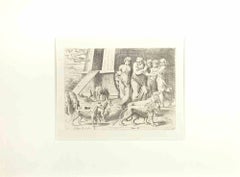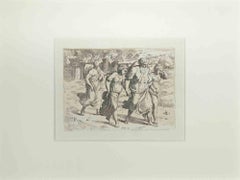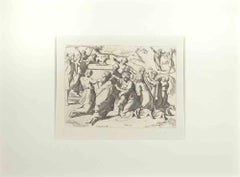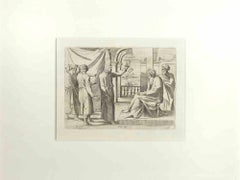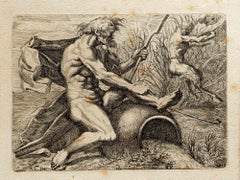17th Century Art
to
157
172
110
17
15
13
Overall Width
to
Overall Height
to
3,418
7,480
43,246
43,355
199
361
777
1,168
969
4,011
6,897
10,305
5,997
2,825
3,013
92
89
1
225
96
2
234
114
91
82
64
61
61
58
47
35
34
34
22
15
15
12
8
8
8
7
198
82
35
34
19
28
26
19
14
10
25
327
250
46
Period: 17th Century
Framing Options Available
Samuele 11 - Old Testament Story - Etching by Sisto Badalocchio - 1607
Located in Roma, IT
Samuele 11 - Old Testament Story is an original Etching print realized by the artist Sisto Badalocchio.
About The Old Testament Story, 1607 ca.
Pas...
Category
Old Masters 17th Century Art
Materials
Etching
Genesis 8 - Old Testament Story - Etching by Sisto Badalocchio - 1607
Located in Roma, IT
Genesis 8 - Old Testament Story is an Etching print realized by the artist Sisto Badalocchio.
About The Old Testament Story, 1607ca.
Passpartout in...
Category
Old Masters 17th Century Art
Materials
Etching
Genesis 19 - Old Testament Story - Etching by Giovanni Lanfranco - 1607s
Located in Roma, IT
Genesis 19 - Old Testament Story is an Etching print realized by the artist Giovanni Lanfranco.
About The Old Testament Story, 1607ca.
Signed on the plate: Gio. L . Passpartout in...
Category
Old Masters 17th Century Art
Materials
Etching
Genesis 32 - Old Testament Story - Etching by Giovanni Lanfranco - 1607s
Located in Roma, IT
Genesis 32 - Old Testament Story is an Etching print realized by the artist Giovanni Lanfranco.
About The Old Testament Story, 1607ca.
Passpartout included 29 x 39 cm
The artwork...
Category
Old Masters 17th Century Art
Materials
Etching
Genesis 41 - Old Testament Story - Etching by Giovanni Lanfranco - 1607s
Located in Roma, IT
Genesis 41 - Old Testament Story is an Etching print realized by the artist Giovanni Lanfranco.
About The Old Testament Story, 1607 ca.
Passpartout included 29 x 39 cm
The artwork...
Category
Old Masters 17th Century Art
Materials
Etching
Man and Satyrs - Etching by Marcantonio Bellavia - 17th Century
Located in Roma, IT
Man and Satyrs is an old master artwork realized in 17th Century by Marcantonio Bellavia.
Black and white etching.
Good conditions (some foxings and stains on paper).
Category
Modern 17th Century Art
Materials
Etching
The King and the Queen - Etching after Domeniquin (Domenichino) by G. Audran
Located in Roma, IT
The King and the Queen is an original artwork realized by Gérard Audran in the second half of the XVII century. Original etching on paper. Signed on the lower right corner.
Etching ...
Category
Modern 17th Century Art
Materials
Etching
Le Repos Pendant la Fuitre en Egypte - Original Lithograph - 17th Century
Located in Roma, IT
Le Repos Pendant la Fuitre en Egypte is an original Lithograph realized by an unknown artist of Italian School in 17th Century.
Good condition on a yellowed paper.
No signature.
Category
Old Masters 17th Century Art
Materials
Etching
$270 Sale Price
25% Off
Planimetry of the Vatican - China Ink After G.L. Bernini - Mid-17th
Located in Roma, IT
Planimetry of the Vatican After G.L. Bernini is an original China Ink realized by an unknown artist in mid-17th century.
Good condition except for some spoiled yellowed paper on mar...
Category
Old Masters 17th Century Art
Materials
Ink
$2,522 Sale Price
25% Off
Architecture - Etching by Jean Le Potre - 17th Century
Located in Roma, IT
Architecture is an original etching realized in the 17th Century by Jean Le Potre (1618-1682).
Fair conditions with some cutaways.
The artwork is depicted through soft strokes in d...
Category
Modern 17th Century Art
Materials
Etching
$450 Sale Price
25% Off
Frontispiece for "Diversi Animali" - Etching by A. Tempesta - 17th Century
Located in Roma, IT
Diversi Animali is an original Etching realized by Antonio Tempesta in the 17th Century.
Good Conditions.
The artwork is depicted through strong strokes with perfect Hatchings.
Category
Modern 17th Century Art
Materials
Etching
The Brain - From De Humani Corporis Fabrica - by Andrea Vesalio - 1642
Located in Roma, IT
The Brain is a original etching realized as plate no. 41 of Andrea Vesalio's "De Humani Corporis Fabrica".
The "De Humani Corporis Fabrica is commonly considered a major advance i...
Category
17th Century Art
Materials
Etching
$901 Sale Price
25% Off
The Horse - Etching by Antonio Tempesta - 1610s
Located in Roma, IT
The Horse is a wonderful black and white etching on thick laid paper, realized by the Italian master Antonio Tempesta (1555-1630).
Not signed.
In excellent conditions.
Including ...
Category
17th Century Art
Materials
Etching
$315 Sale Price
25% Off
The Buffalo - Etching by Antonio Tempesta - 1610s
Located in Roma, IT
The Buffalo is a wonderful black and white etching on thick laid paper, realized by the Italian master Antonio Tempesta (1555-1630).
Not signed.
In excellent conditions.
Including a cream-colored cardboard passepartout, 34 x 50 cm.
An exciting original print, with all the dignity of a mythological or epic story, represented with an incredible balance of black and white, light and shadow, and a typical Baroque dynamism.
Antonio Tempesta, also known as Il Tempestino (Florence, 1555 - Rome, 1630), was an Italian painter and engraver of the early Baroque period. Antonio Tempesta trained in the culture of late Mannerism, with a naturalistic but also calligraphic taste, acquired from the frequentation of Giovanni Stradano, with whom he collaborated in the decoration of Palazzo Vecchio.
Moving to Rome in 1573, he worked for Pope Gregory XIII, frescoing some maps of Rome in the Vatican, including the famous Map of Rome (1593). In the pontifical capital, he worked for many noble families and for important cardinals, such as Alessandro Farnese and Scipione Borghese. His works are in San Giovanni dei Fiorentini, at the villa in Caprarola, in Tivoli.
He returned to Florence for a brief stay, where he collaborated with Alessandro Allori...
Category
17th Century Art
Materials
Etching
$225 Sale Price
25% Off
The Monkey - Etching by Antonio Tempesta - 1610s
Located in Roma, IT
The Monkey is a wonderful black and white etching on thick laid paper, realized by the Italian master Antonio Tempesta (1555-1630).
Not signed.
In excellent conditions, except for some stains.
Image Dimensions: 5 x 7 / 8 x 10 cm.
Including a cream-colored cardboard passepartout, 34 x 50 cm.
An exciting original print, with all the dignity of a mythological or epic story, represented with an incredible balance of black and white, light and shadow, and a typical Baroque dynamism.
Antonio Tempesta, also known as Il Tempestino (Florence, 1555 - Rome, 1630), was an Italian painter and engraver of the early Baroque period. Antonio Tempesta trained in the culture of late Mannerism, with a naturalistic but also calligraphic taste, acquired from the frequentation of Giovanni Stradano, with whom he collaborated in the decoration of Palazzo Vecchio.
Moving to Rome in 1573, he worked for Pope Gregory XIII, frescoing some maps of Rome in the Vatican, including the famous Map of Rome (1593). In the pontifical capital, he worked for many noble families and for important cardinals, such as Alessandro Farnese and Scipione Borghese. His works are in San Giovanni dei Fiorentini, at the villa in Caprarola, in Tivoli.
He returned to Florence for a brief stay, where he collaborated with Alessandro Allori...
Category
17th Century Art
Materials
Etching
$225 Sale Price
25% Off
The Fawn - Etching by Antonio Tempesta - 1610s
Located in Roma, IT
The fawn is a wonderful black and white etching on thick laid paper, realized by the Italian master Antonio Tempesta (1555-1630).
Image Dimensions: 5 x 7 / 8 ...
Category
17th Century Art
Materials
Etching
$225 Sale Price
25% Off
Interior Meeting - Original Etching by Cornelis Meyssens - 17th Century
Located in Roma, IT
Interior Meeting is an original etching realized by Cornelis Meyssens ( 1640-1573).
Good conditions, except for some foldings.
Included a Passepartout: 34 x 49 cm
The artwork repres...
Category
Baroque 17th Century Art
Materials
Etching
Ox - Etching by Antonio Tempesta - 1610s
Located in Roma, IT
Ox is a wonderful black and white etching on thick laid paper, realized by the Italian master Antonio Tempesta (1555-1630).
Not signed.
In excellent conditions.
Image Dimensions:...
Category
17th Century Art
Materials
Etching
$225 Sale Price
25% Off
Le Bouffon et les Deux Couples Amoureuses - Original Etching - 1514
Located in Roma, IT
Image dimensions: 7 x 9 cm.
Les Bouffon et les deux couples Amoureuses is an original artwork realized after Hans Sebald Beham in 1514.
Original burin on paper; late 17th century edition.
Good conditions.
The artwork is a very small yet well-balanced composition representing a genre scene.
The original artwork was realized after Hans Sebald Belham (Neuremberg, 1500 – 1550). Belham was a German painter and etcher, mainly known for his very small engravings, like this artwork itself. He spent the latest part of his career in Frankfurt. He was one of the most important so-called "Little Masters...
Category
17th Century Art
Materials
Etching
$270 Sale Price
25% Off
Plants - Original China Ink Drawing by Jan Pieter Verdussen - 1740
Located in Roma, IT
Plants is a beautiful artwork realized by Jan Peter Verdussen in 1740.
pen and watercolour on brown paper. In good codition except for some pencil marks and traces of sealing wax on...
Category
Old Masters 17th Century Art
Materials
Paper, Ink
Old Masters Chalk Drawing, 17th Century Italian Sanguine on Paper
Located in London, GB
Sanguine chalk on paper
Image size: 7 x 8 1/2 inches (18 x 22 cm)
Acid free cut-out mount
This 17th century drawing depicts a reclining woman with her back.
The Sanguine chalk that...
Category
Italian School 17th Century Art
Materials
Paper, Chalk
Theodoor Galle Martin de Vos 17th Century Engraving Jesus Before Pilate
Located in London, GB
We have the full series of 52 prints (including title page) from Vita Passio et Resurrectio Iesu Christi listed. To find the others scroll down to "More from this Seller" and below it click on "See all from this Seller" and search for 'Collaert' - or message us as they may not all have been uploaded yet.
Theodoor Galle...
Category
Realist 17th Century Art
Materials
Engraving
Theodoor Galle Martin de Vos 17th Century engraving The Widow's Mite (Offering)
Located in London, GB
We have the full series of 52 prints (including title page) from Vita Passio et Resurrectio Iesu Christi listed. To find the others scroll down to "More from this Seller" and below i...
Category
Realist 17th Century Art
Materials
Engraving
Theodoor Galle Martin de Vos Engraving The Suffering Servant
Located in London, GB
We have the full series of 52 prints (including title page) from Vita Passio et Resurrectio Iesu Christi listed. To find the others scroll down to "More from this Seller" and below it click on "See all from this Seller" and search for 'Collaert' - or message us as they may not all have been uploaded yet.
Theodoor Galle...
Category
Realist 17th Century Art
Materials
Engraving
Theodoor Galle 17th Century Engraving Suffer the Little Children Martin de Vos
Located in London, GB
We have the full series of 52 prints (including title page) from Vita Passio et Resurrectio Iesu Christi listed. To find the others scroll down to "More from this Seller" and below it click on "See all from this Seller" and search for 'Collaert' - or message us as they may not all have been uploaded yet.
Theodoor Galle (1571 – 1633), Iacob de Bye (1581-1640) after Maerten de Vos (1532 - 1603)
29. Sinite paruulos, et nolite eos prohibere ad me venire : talium est enim reguum coelorum 19.
Engraving
From Vita, Passio, et Resurrectio Iesu Christi first published 1598, this a later edition published by Joannes Galle (1600-1676)
16.5x21.8cm
Hand-finished black wooden frame available
From the Gospel of Matthew, chapter 19 "Suffer the little children...
Category
Realist 17th Century Art
Materials
Engraving
View of a Cathedral, 17th Century Dutch Ink and Wash Artwork, Mounted
Located in London, GB
Ink and wash on paper
Image size: 7 1/2 x 6 inches (19 x 15.25 cm)
Mounted
This drawing is of a Gothic style church in the Netherlands that is likely to have been built in the 15th ...
Category
17th Century Art
Materials
Paper, Ink
Study of a dog
Located in Amsterdam, NL
Study of a dog
Oil on paper laid down on panel, 17.5 x 25.5 cm
Provenance
Private collection, the Netherlands
Note:
We are grateful to Mr Fred Meijer for his attribution to Ludolf de Jongh
Ludolf de Jongh was the son of a shoemaker. When his father moved to Rotterdam, the young Ludolf decided to learn art rather than shoemaking and became a pupil of Cornelis Saftleven. Later he studied under Anthony Palamedes in Delft and still later with Jan van Bijlert in Utrecht.
In 1635 he travelled to France with Francis Bacon. Seven years later, in 1642, he returned to the Netherlands when he heard that his mother had fallen ill. He set up a shop in Rotterdam, and his earliest signed paintings date from that year.
According to Houbraken, his travels had caused him to speak French so fluently, that his parents had to learn French in order to speak with him.
De Jongh’s work shows a strong influence from the Utrecht school of Caravaggio admirers, especially Jacob Duck...
Category
Old Masters 17th Century Art
Materials
Paper, Oil, Wood Panel
Price Upon Request
Recently Viewed
View AllMore Ways To Browse
18th Century Dutch Oil Paintings
19th Century Oil Painting Pastoral Scene
1965 Watch
Wrestler Sculpture
15th Century Italian Painting
Wrestling Vintage
1962 Watch
18th Century Oil Painting Woman
1965 Vintage Watch
1984 Clothing
19th Century Painting Lovers
Woman Posing Seated
1974 Vintage Watch
1930s Actress
1953 Watch
Wood Carving Portrait
18th Century Venetian Paintings
1980 Japanese Poster

